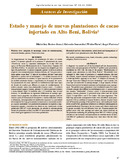Mostrar el registro sencillo del ítem
Estado y manejo de nuevas plantaciones de cacao injertado en Alto Beni, Bolivia
| dc.contributor.author | Bentes Gama, Michelliny | es_ES |
| dc.contributor.author | Somarriba, Eduardo | es_ES |
| dc.contributor.author | Pinto, Waldo | es_ES |
| dc.contributor.author | Pastrana, Angel | es_ES |
| dc.contributor.other | CATIE - Centro Agronómico Tropical de Investigación y Enseñanza | |
| dc.date.accessioned | 2015-03-19T21:28:50Z | |
| dc.date.available | 2015-03-19T21:28:50Z | |
| dc.date.issued | 2005 | |
| dc.identifier | 469734 | es_ES |
| dc.identifier.issn | 1022-7482 | es_ES |
| dc.identifier.uri | https://repositorio.catie.ac.cr/handle/11554/6229 | |
| dc.description | 3 tablas, 15 ref. | es_ES |
| dc.description.abstract | Se diagnosticaron los hogares, las condiciones de sitio y el estado actual y el manejo aplicado en la primeras 57 plantaciones de cacao (Theobroma cacao L.) injertado establecidas en el año 2003 con apoyo de Proyecto Modernización de la Cacaocultura Orgánica del Alto Beni, Bolivia. Se identificaron las siguientes deficiencias de manejo agronómico: hoyos pequeños sin adición de fertilizante orgánico, falta de tutores y poda de formación de los injertos y sombra deficiente (exceso o deficiencia, heterogeneidad de distribución espacial). Los productores plantaron sus injertos a espaciamientos amplios y mezclaron los clones al azar (incluyendo el clon polinizador IMC-67) en la plantación, sin atender la recomendación técnica de plantarlos en filas, con IMC-67 intercalado cada tres filas de otros clones para optimizar su rol como polinizador. A diagnosis was carried out of the household and site characteristics, actual status and management of the first 57 grafted cacao plantations established in 2003 with the help of the project “Modernization of organic cacao plantations in Alto Beni, Bolivia”. The following agronomic management faults were identified: small planting holes with no addition of organic fertilizer absence of plant tutors and of formation pruning of the grafted cacao and inadequate shade levels in half of the plantations (excessive or deficient inhomogeneous spatial distribution). Farmers planted the grafted cacao with wide spacings and mixed the clones randomly in the plantation (including the polinizing clone IMC-67) without paying attention to the technical recommendation to establish clones in lines, with IMC-67 (pollinator) alternating every three lines with the other clones. | es_ES |
| dc.language.iso | es | es_ES |
| dc.publisher | CATIE, Turrialba (Costa Rica) | es_ES |
| dc.relation.ispartof | Agroforestería en las Américas, números 43-44 (2005), páginas 67-71 | |
| dc.rights | info:eu-repo/semantics/openAccess | es_ES |
| dc.subject | PLANTACION | |
| dc.subject | PRACTICAS AGRICOLAS | |
| dc.subject | TECNOLOGIA | |
| dc.subject | ADOPCION DE INNOVACIONES | |
| dc.subject | COSTOS DE PRODUCCION | |
| dc.subject | EDUCACION | |
| dc.subject | RENDIMIENTO | |
| dc.subject | COOPERATIVAS | |
| dc.subject | PLANTAS DE SOMBRA | |
| dc.subject | BOLIVIA | |
| dc.subject | THEOBROMA CACAO | es_ES |
| dc.subject.other | Sede Central | |
| dc.title | Estado y manejo de nuevas plantaciones de cacao injertado en Alto Beni, Bolivia | es_ES |
| dc.title.alternative | Household and site characteristics, actual status and management of new grafted cacao plantations in Alto Beni, Bolivia | es_ES |
| dc.type | Artículo | es_ES |


